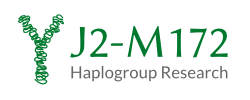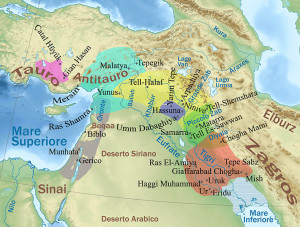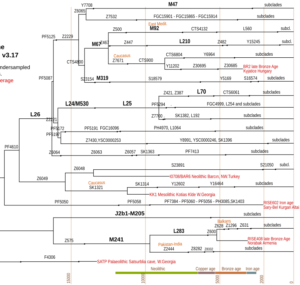The estimates are based on partial consensus Y-mutation rate of 0.82×10^-9 mutations/nucleotide/year for a defined Y-sequence area (comBED, 857 regions, 8.4 mbp) using SNP counting (See Adamov et al. 2015, 0.82 also in Poznik et al. 2013, 0.8 in Fu et al. 2014, 0.78 in Balanovsky et al 2015, 0.87 in Helgason et al. 2015). The calibration by Adamov et al. was based mainly on Anzick-1 (Q1a2a1b-Z780, 12632 years BP) with verification trough 41 samples representing 14 genealogies (0.80), Ust-Ishim (0.78, K-M2335, 45000 years BP), Kostenki-K14 (max. 1.08, C1-K29, 37000 years BP). The rate seems consistent for haplogroups ca. 13,000 years old, for genealogical time-frame slightly higher mutation rates might be informative (0.87 Helgason et al. 2015, 753 males, 274 patrilines, 15.2 Mb Y-sequence, 1,365 meioses, 47,123 years).
The J2 haplogroup evolved in or near Western Asia, likely in the area delimited by: Eastern Black Sea, Southern Caspian Sea, Zagros Mountains slopes and Glacial Arabo-Persian Gulf Oasis. It separated from the J1 clade ca. 31,600 ybp and diversified in J2a and J2b ca. 26,800 ybp.
J2 main subclades tree with time estimates based on YFull YTree v3.17 (Rottensteiner 2016)
Further estimates including 95% CI see YFull YTree J2.
Range of age estimates for Y-chromosome and mtDNA haplogroups connected to estimates for expansion of modern Proto-Eurasians (non-African). See for example (BP = before present):
- YFull YTree v8.07.00 2020-08: CT-M168 formed 88,000 ybp, TMRCA 68,500 ybp
Experimental YTree v3.6: CT-M168 formed 86,300 years, TMRCA 68,300 years - Robb 2012: CDEF-M168 54,000-66,000 years, J 21,000-28,000 years,
- Wei et al. 2013: CDEF-M168 57,000-74,000 years,
- Francalacci et al. 2013: F-R haplogroup ca. 110,000 years
- Iñaki Comas et al. 2013: MTBC age ca. 70,000 years
- S. Gopalakrishnan et al. (unpublished): Eurasian expansion ca. 75,000 years
- Rieux et al. 2014: coalescence of mtDNA L3 72,000 years [54-93 95% HPD]
Further evidence:
For a calibration point set at CDEF-M168 (see phylotree.org/Y) with 70 ka (kiloannus = thousend years) ago according to Karafet et al. 2009 the matching Y-Mutation rate is ca. 0.8×10^-9 mutations/nucleotide/year.
See also


